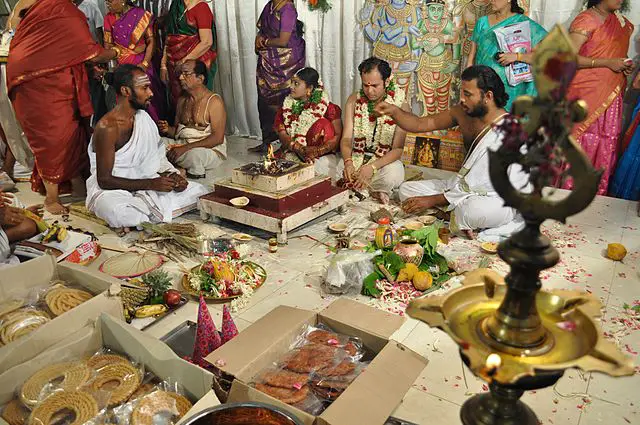
According to Hindu Religion, there are four stages that humans have to pass through in life before attaining salvation or Moksh. Marriage and family life is the second phase when an individual gets married, has children, earns wealth and enjoys life till he/she enters the third stage. Moreover Hindus believe that marriages are made in heaven and so there is someone waiting for every person to tie the knot when the right moment arrives. The main idea is to unite two souls through marriage which is a sacrament that has moral and ethical values.
Fact 1: Hindu wedding is one of the most fascinating rituals and is performed with glamour and lavishness to make the event a memorable one for life. Since the Hindus are divided into various castes, each caste has its specific rituals and methods of performing the holy rites of marriage.
Fact 2: Since Hindu marriage is a union of two souls as well as two families, the primary witness is the fire-god also known as Sacred Fire or Agni. A marriage is considered complete only after seven encirclements are completed around the Sacred Fire by the bride and the groom among enchantment of the mantras.
Fact 3: There are eight different types of Hindu marriages. They are:-
- Brahma Marriage;
2. Daiva Marriage;
3. Arsha Marriage;
4. Prajapatya Marriage;
5. Gandharva Marriage;
6. Asura Marriage;
7. Rakshasa Marriage and
8. Paishacha Marriage.In most of these forms of marriages, the father gives away his daughter to a groom of good conduct and able to take care of her for life and who promises to never leave her ever in life.
Fact 4: Hindu marriage is an elaborate process and lasts for about 10 days starting from the agreement of parents of both the bride and the groom. Then on the auspicious day, the various rituals that follow one another are the following:
- Swagatam and Madhuparka or welcoming the groom and his family with sweets when they arrive at the wedding venue.
- Prayers to Lord Ganesha are offered to bless the couple and make the marriage an ever-lasting one.
- Blessings of elders and forefathers are also sought.
- Vadhuagaman or arrival of the bride.
- Mangalashtakam and Sankalpa or mutual acceptance of the bride and groom that is asserted by garlanding each other. The priest utters the special words called Mantras to complete the promise of the couples to be with each other for life.
- Kanyadaan or giving away of the bride by the father is one of the most important act in a Hindu marriage. Although it is a painful act, the marriage has to be completed by this ritual followed by tying the sacred thread together on the couple’s wrists known as Sutrabandhanam.
- Mangalasutrabandhanam is the necklace that the groom ties on the bride’s neck as a symbol of love, luck and friendship. Then the kumkum ceremony follows where the bride’s forehead is smeared with red powder called kumkum. Wedding rings are exchanged also and then a permanent knot is tied.
- Vivah Homa or Wordhipping the Sacred Fire.
- Agnipradakshina which symbolizes the start of the married life and it is done amidst the chanting of mantras.
- Ashirvad or Blessings is the last event in a Hindu marriage. The couple bow their heads to all elders seeking their blessings for their future life.
Although the ceremonies vary from one state to another, the rituals and the Vedic mantras are more or less the same in all Hindu marriages. The elaborate decorations and innumerable cuisines served for the guests are unique and probably the best known in the world.










Leave a Reply